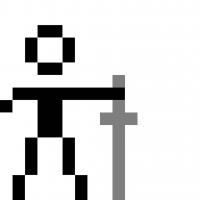To spin off a more general discussion from another thread:
Because apparently someone doesn't like crossing the streams when people get geeky, ![]() But mostly because it seems like a fairly decent lounge topic covering a wider scope, and holds a good chance of kicking out some ideas and conversations which also impact game development that don't really need to drown out talks on a specific movie. So, why not have a more general topic on the issue?
But mostly because it seems like a fairly decent lounge topic covering a wider scope, and holds a good chance of kicking out some ideas and conversations which also impact game development that don't really need to drown out talks on a specific movie. So, why not have a more general topic on the issue?
A writer's failure to stay consistent within their own ruleset that they have developed for their world has always been one of the fastest ways for my enjoyment as a reader/viewer of it to be diminished. As a sometimes game developer and writer myself, dealing with the issue of "power creep vs power leap" and maintaining engagement has been a problem. If you have "Super powerful awesome technology", just how does it remain balanced and interesting, and not break everything within your setting.
I figure people on a site like this can probably come up with a lot of examples of both good and bad ways these issues have been handled in various settings.
I feel that the issue of consistency and of power jumps kind of go hand in hand in many ways, but they are also closely tied to what I, as a writer, think of as 'considering all of my options'.
As an example, a point brought up in the other thread from Star Trek was their rules base around shields and transporters. I don't have every episode of all series memorized, but it did seem to me that they were fairly consistent on transporters not working safely, if at all, through the ships shields. They mostly remained consistent on that point, and the few counter points I can think of all had clearly defined 'gotchas' to them that made them fairly specific to a given situation when they made exception to that rule. But teleporters are the kind of technology which raises very serious questions about power and possibilities. "If I can teleport something from one point to nearly anywhere, then why not just teleport a warhead next to their reactor and be done with it?" is 'kind of an important question to answer' if you want your audience to see the world you're creating as something deeper than the paper it was written on.
In that case the writers went with a fairly straightforward "Well, you can't..." by simply declaring that "Everyone has shields, and you can't transport through them" (Which is then given the caveat of 'except when we want to, because, reasons...' I guess.)
So with a given power or technology, or even just a situation characters find themselves in, I strongly feel that we, as creators, must sit down and "Think through all our options". An example that was only kind of ever address in Star Trek with regards to its teleportation technology is "Why does anyone carry a phaser/disrupter?" Why not a tricorder like scanner with a "pocket teleporter" that can move a few millilitres of material from point to point within a few hundred meters. - That is, rather than jumping out from behind a rock to shoot at someone with your fancy space gun, why not continue to cower behind your nice safe rock, and teleport a few grams of brain matter out of the guy shooting at you? (As I was writing this I remembered a Deep Space Nine episodes where they had a "Bullet teleporting sniper rifle" which didn't really get beyond prototyping stage. But even that has its own issues and questions.)
The Dune series takes an interesting, but also flawed approach, to countering the question of "What is stopping them from just using this tech and steam rolling everything" with their lasgun technology by adding in "Personal Shield" technology to the mix. However a very large flaw in this was how he explained why it stopped lasguns from being the end all and be all of combat, and went a little overboard by establishing that they're often "A very bad idea" because they have the tendency of causing random nuclear bomb like explosions and either end, or both.
- Two questions then quickly come up when we step back and consider our options with Dune lasguns and shields:
1. If armies frequently employed both shields and lasguns in the field, then how exactly were random accidental nuclear explosions not a common thing from someone taking a shot with a lasgun at the same time someone panics and flips on their shield? Personally I'm kind of left with the thought of "Well maybe we shouldn't give these nuclear explosion prone rifles to our troops, and we'll give them something else to shoot with instead", but maybe that's just me.
2. If personal shields that fit comfortably on a belt are common, and people commonly move about with small lasguns, and firing a lasgun at an active shield almost always causes a nuclear like explosion to go off... Then why aren't people rigging a timer up with a lasgun pointed at a personal shield, and catching the next shuttle off the planet?
Which makes me think of Dune as an excellent example of an over correction in power abuse. From a writing standpoint it could very easily have been that lasguns were perfect against unshielded targets, but then utterly ineffective against anything with a shield. A devastating machine gun against poorly equipped targets, but little more than a marshmallow pop gun against anyone who flicked a shield on. By going so far as to say "We'll have our heroes use knives and swords and looking cool because they risk Nuclear Explosions! if they didn't", it brings up its own set of other problems to deal with rather than just going "Well, they do that, because the other cool weapons get nullified in these instances".
Even just failing to consider the situation and tools available has made for some nasty missteps in movies. A big example is in the early act of The Force Awakens (Which seems old enough to openly talk about, unlike The Last Jedi which many of us haven't seen yet) where they are escaping the ship in their stolen TIE fighter - They make a big deal about "having to take out the cannons before we escape" in one scene, then fly by a bunch while blowing up one before making their escape. Which looks epic and cool on screen, but then has the glaring hole that I found jarred me out of the moment as I was watching. "Well, why didn't they fire at them with the rest of the cannon thingies? Or launch a bunch more of those TIE fighters still sitting in the hangar to intercept them..."
Even if we assume they were caught by surprise and it took longer than usual to scramble fighters to go after them, then why didn't the capital ship just watch where on the planet they crashed, and then spot them by sending swarms of flybys around the area before either of them could get to 'civilization'?
A very simple change that could have been just as epic on screen, and waved away the problem of the very logical options would have been to say "Well, we have a group of heroes in a TIE fighter that is already inside the ship and past all the core defences... Blow something up inside, have a scene with the bridge crew cursing over how badly damaged and crippled they are, and how poorly damage control is handling things..." The heroes get to fly off safely, for a time, and buy themselves some breathing room, but no so much as to remove the threat entirely. - Damage control gets things squared away 'some time later', and the baddies start to game of catchup in a logical manner in a sensible time frame.
From a more game related point, I think that many "Point and click" puzzle adventure games end up with at least one awkwardly done puzzle chain that leaves the player looking at things and saying "Well, why don't I just pick up that rock shown in the background art right there, and smash this window, and bypass a bunch of these puzzles?", but plenty of other games can still suffer from the issue of "Well if the technology allows X, why not use it to do Y and get around things/kill the baddies more easily?"
- But as a total side note, I've often thought about making a Monkey Island like game where every puzzle has two options: Solve the 'real' puzzle and jump through the normal hoops, or just smash things with a rock/use your pocket knife to 'solve' the problem. With suitable in game commentary over your choice.












